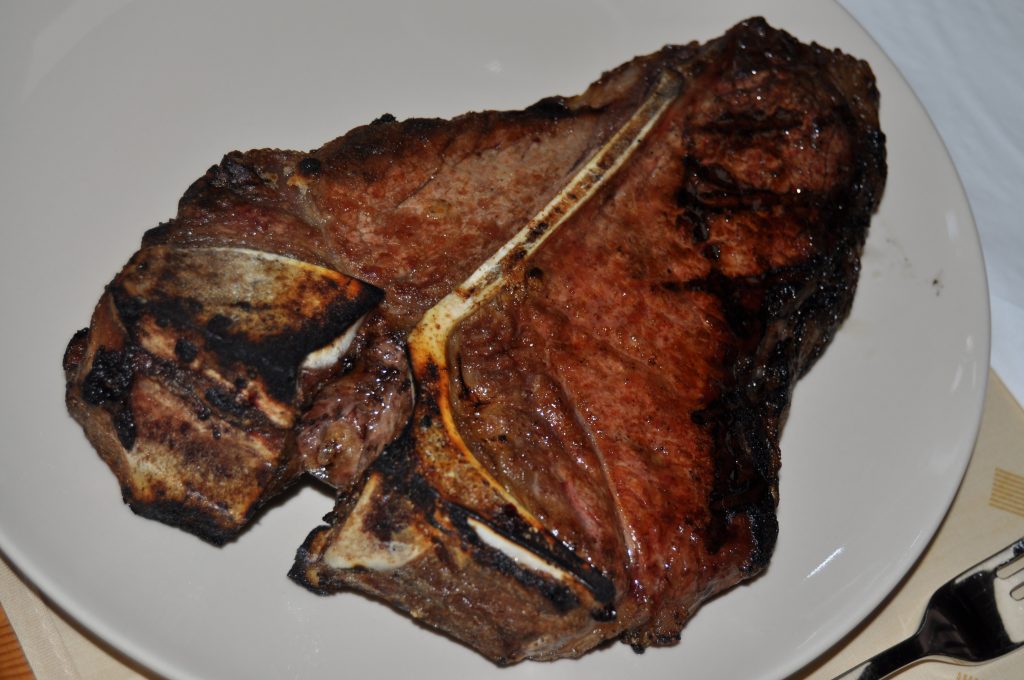Dry aging is more than just a fashion term: Dry aging refers to the dry aging of meat on the bone. The basic idea of dry aging is almost as old as butchery itself – traditional butchers have known about the benefits of dry aging meat for generations. In fact, dry aging was the most common method of meat aging until the 1970s, when the method began to drop out of fashion. In order to provide large masses of meat, other – less expensive – aging methods were developed.
Dry aging is a way of refining particularly well-marbled meat, making it even more flavorful. A few years ago, the craft of dry aging was rediscovered and became a trend that can hardly be ignored by steak lovers.
Even the best meat is inedible immediately after slaughter.
Why does Dry Aging make sense?
Every piece of meat that is consumed by humans must be aged: Immediately after slaughter, meat is inedible. The muscles of the meat contract and the meat is chewy. Even the best meat is inedible immediately after slaughter. This is due to the fact that the animal’s cellular metabolism continues for some time after slaughter. This is the first phase of meat maturation: cell metabolism must come to a standstill.
During this process, lactic acid is produced: the process makes the meat chewy at first, but after a maturing period, the positive effects of lactic acid appear.
Dry Aging and Wet Aging
The second phase of meat aging produces enzymes that loosen the muscle structure of the meat, making it much more tender.
There are two methods of aging meat: Wet Aging and Dry Aging.
Wet Aging has been the most common method of meat aging since the seventies because it is much less expensive and less time-consuming. In wet aging, the meat is removed from the bone and vacuumed. The meat then matures in the vacuum bag at 0 degrees Celsius for over two weeks. In this process, the meat matures practically in its own juices without oxygen: This proven method is mainly used today. In contrast to dry aging, wet aging does not result in any weight loss due to evaporation. However, this also hardly changes the taste of the meat.
Unique flavors await the meat connoisseur.
Dry Aging Process
However, if one wants to produce pieces of meat with outstanding taste, one chooses dry aging: For this, the meat is hung in special cooling chambers, which are tempered between 0 and 2 degrees Celsius. It is important that the pieces of meat remain on the bone. For the producer, Dry Aging means that the meat loses at least 20 percent of its weight through evaporation. This also affects the price of Dry Aged meat.
In addition, Dry Aging requires specially air-conditioned premises. Last but not least, Dry Aging is riskier than Wet Aging: It can never be completely ruled out that the meat takes on an unwanted flavor due to unpredictable biochemical processes. However, if dry aging is successful, meat connoisseurs can expect unique flavors. Dry aging is used for both pork and beef: however, beef is traditionally usually aged longer than pork.

Why does Dry Aged meat taste different?
The permanent oxygen contact increases the enzyme activity in the meat: The higher the enzyme activity, the more intense the meat flavor. This is particularly evident, for example, in a Dry Aged T-bone steak. Some butchers use salt stones in their aging rooms, which further enhance the flavor. Modern curing chambers can also do without salt stones.
Contrary to what is often claimed, dry aging does not serve to tenderize the meat, but to develop the flavor: After ten days of aging, a piece of meat hardly becomes any more tender. However, the flavor continues to intensify: the aging time is almost unlimited. Typical maturing times for Dry Aged meat are between four and eight weeks. Longer maturing times are particularly common in the USA and Asia, where very long-matured meat is considered a delicacy.
Renaissance of Dry Aging
The secret of dry aging is the extraction of (mostly tasteless) liquid from the meat: the loss of liquid makes the meat much more aromatic. The enzymes that are activated during aging further enhance the meat flavor.
What fell victim to the need for large masses of meat in the seventies is now common practice again: dry aging has experienced a veritable renaissance in recent years.
Although dry aging is a more elaborate and riskier method of aging than wet aging, numerous butchers are once again relying on dry aging: What used to be standard is now the favorite choice of numerous meat connoisseurs who appreciate particularly intense meat flavors.
Cover picture: Slicing of a dry aged T-bone steak, © Simon von Ludwig

 Deutsch
Deutsch